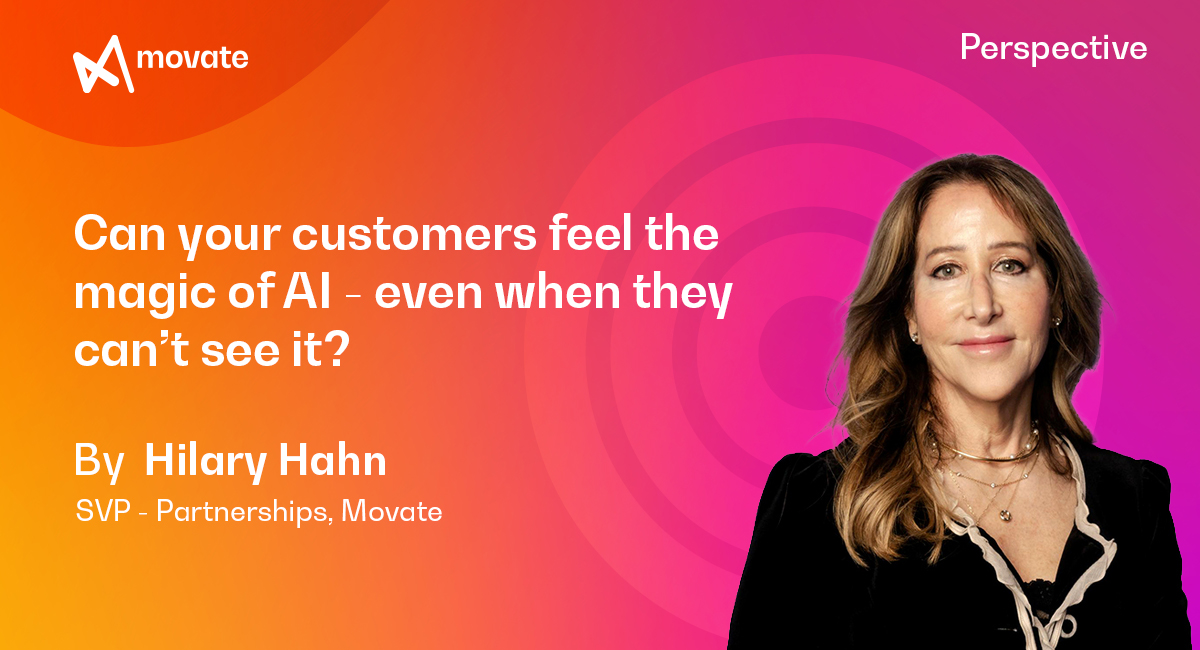
Customer experience has entered a new age. Proactive engagement now defines a sector that once relied on reactive support. As customer demands and expectations evolve, doubling down on the experience yields incredible results.
According to a Zippia report, customers are likely to spend 140% more after a positive experience rather than a negative one. Similarly, data by CX Index shows that customer-centric brands experience profits that are 60% higher than those that fail to focus on CX. These numbers tell a clear story: delivering an outstanding experience directly drives revenue, loyalty, and long-term business value.
To provide consistently excellent customer experiences, enterprises are turning to “invisible AI”; this is AI that works flawlessly in the background, orchestrating smooth and intelligent interactions without customers noticing the mechanics behind them. Customers still interact with chatbots, human agents, and digital platforms, and now real magic lies in the invisible orchestration that makes those engagements effortless and personalized. It is this invisible layer of AI that represents the new frontier in CX.
What Makes AI Invisible in CX: Reducing Friction Across Touchpoints
The most meaningful AI does not have to be the loudest. “Invisible AI” is not about flashy interfaces or visible automation; it is about seamlessly embedding intelligence into processes so that customers experience frictionless journeys without being aware of the complexity driving them.
Several key characteristics define invisible AI:
- Proactive and Anticipatory: The true power of invisible AI lies in predicting what customers will need before they ask. By analyzing behavioral signals, purchase history, and contextual patterns, it can resolve issues or surface recommendations ahead of time. For example, by analyzing unusual device or vehicle activities, the invisible AI system might automatically schedule a service appointment. This proactive approach reduces friction and creates the sense that the brand always “has the customer’s back.”
- Contextual Personalization: While personalization has long been a CX buzzword, invisible AI takes it to a new level. Driven by complex data analysis in the background, these AI systems deliver contextual personalization by tailoring customer experiences in a positive way that feels that the brand “knows” them. Instead of offering generic product suggestions, these systems customize CX according to time of day, location, prior interactions, and even sentiment.
- Channel Fluidity: Lack of fluidity can be a major frustration for customers, requiring them to repeat their preferences across channels. Invisible AI effectively eliminates that pain point. It carries context from one channel to another. This means details shared with a chatbot are carried through to a phone agent, or an issue flagged in an app is already understood when the customer switches to email. The result is seamless continuity across platforms, with customers feeling recognized at every step.
In essence, invisible AI can be considered a silent concierge rather than a loud and obvious agent. While a visible chatbot or digital assistant engages directly, invisible AI works in silence, preemptively taking actions to make the entire experience feel natural.

The Evolution of AI in CX: Why Being Frictionless Matters
Over recent years, AI in CX has followed a clear trajectory. It began with simple rule-based bots that offered limited value. The next wave introduced conversational AI and predictive analytics, creating smarter interactions but still requiring visible engagement.
Now, the next leap forward is here: the integration of invisible AI that orchestrates end-to-end experiences. Eradicating friction points such as long wait times, repetitive requests, and broken handoffs between channels is an imperative.
This is only further backed up by the numbers. According to a McKinsey report, 71% of consumers expect personalization, and 76% of them get frustrated when they don’t get it. Similarly, a survey by Salesforce shows that 73% of customers expect companies to understand their unique needs and expectations. It’s undeniable that the customers of today demand seamless journeys across all channels and devices.
In fact, reducing friction directly improves customer stickiness. Customers who glide through problem resolution or purchase processes are far more likely to return, buy more, and recommend the brand. In other words, invisible AI is not just an operational advantage; it is the driving force behind long-term loyalty.
The Enterprise Perspective: Building Customer Stickiness Through Invisible AI
From a business standpoint, invisible AI creates both immediate and long-term advantages, massively boosting CX outcomes.
- Personalization at scale: Customers receive offers and content that feel timely and natural, built on behavioral insights and historical trends.
- Predictive engagement: Needs are anticipated before they surface, transforming support from reactive to proactive.
- Effortless issue resolution: Such AI can automatically provide fixes, reducing the need for escalation.
- Trust and reliability: Experiences that are intuitive and stress-free build customer confidence.
The impact of invisible AI can also be measurable, showing the benefits through numbers. Given its potential, enterprises that use invisible AI to orchestrate journeys are bound to see improvements in Net Promoter Scores (NPS), higher customer satisfaction (CSAT), reduced churn, and an increase in customer lifetime value. As a long held ‘north star’ in customer experience delivery, invisible AI is what enables personalization at true scale.
Challenges and Responsibilities
Along with its advantages, invisible AI also comes with critical responsibilities that need to be respected.
- Transparency: Even as AI operates in the background, customers should feel informed and in control of their data and decisions. In fact, a report by Salesforce highlights that 60% of consumers would have greater trust in AI if there was more customer control over its use.
- Privacy and ethics: Data-driven decision-making must be guided by robust governance and clear ethical frameworks. This ensures that personalization does not come at the expense of trust or compliance.
- Avoiding overreach: AI should enhance, not manipulate, customer interactions. Invisible AI should have the goal of removing friction and delivering value without crossing boundaries and pushing customers to unwanted decisions.
- Human oversight: Even the most advanced invisible AI systems require explainability tools and human-in-the-loop processes. This combination ensures that outcomes remain transparent, and businesses have the power to quickly intervene whenever required.
Balancing invisibility with accountability is essential. Customers may not see the AI, but they must feel confident that the brand is acting in their best interest.

The Future of Invisible AI: Power in What Customers Don’t See
As hyper-personalization becomes an expectation rather than a differentiator, invisible AI will move from an advanced capability to a foundational layer of CX. Most customer platforms will eventually embed invisible AI at their core, shifting the focus from surface-level interactions to intelligent orchestration across journeys.
The winners in our modern business landscape will be the enterprises that customers hardly notice using AI because their experiences just work seamlessly. Invisible AI represents the maturity of customer experience technology, showcasing the shift from individual interactions to effortless engagement.
Customers may not see AI at work, but they feel the difference in prompt solutions and meaningful personalization. For enterprises, the call to action is simple: invest in invisible AI now to prepare for a future where loyalty is shaped not by the technology customers see, but by the intelligence they never notice.

Hilary is a dynamic executive with a passion for building lasting strategic partnerships, crafting and executing go-to-market strategies, and fostering an epic culture. With a proven track record across Fortune 500 companies and new economy brands, she is a thought leader who drives positive change and consistently delivers exponential growth. Known as a disruptor, Hilary has earned the trust of C-suite leaders, colleagues, and clients alike, enabling her to implement transformative ideas and processes. Her approach is grounded in a deep commitment to both employee and customer experience.
A strong advocate for women and diversity in the workplace and on corporate boards, Hilary is dedicated to advancing inclusivity and empowering future leaders.
Connect on LinkedIn
